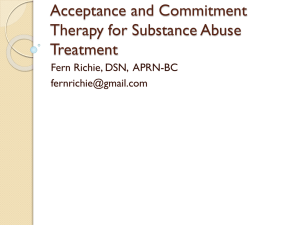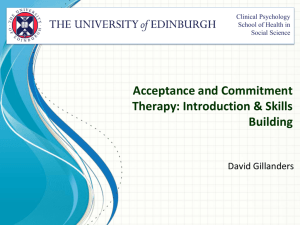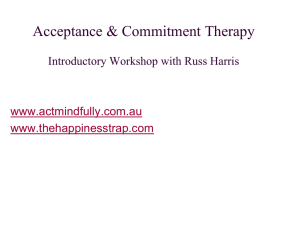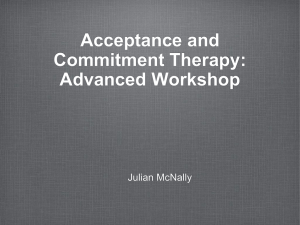Introduction to Acceptance & Commitment Therapy
advertisement
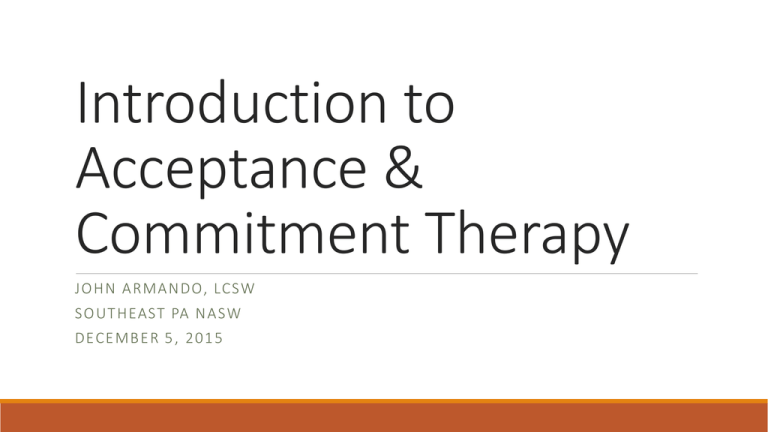
Introduction to Acceptance & Commitment Therapy JOHN A R MA NDO, LCSW S OUT HEAST PA N ASW DECE MBE R 5 , 2 0 1 5 Invitation to emit behavior… You have to emit behavior in order to have it shaped Sally Pete Intro to the Intro to ACT Acceptance & Commitment Therapy is ◦ …built on empirically based principles ◦ …aimed to increase psychological flexibility ◦ …using a mindfulness-based approach ◦ …with behavior change strategies …built on empirically based principles Severe substance abuse Social Phobia Depression Smoking Obsessive-Compulsive disorder Chronic pain Panic disorder Medical problems Generalized anxiety disorder Psychosis Post-traumatic stress disorder Workplace stress Trichotillomania And more… ACT RCTs to May 1st 2013 73 RCTs …aimed at increasing psychological flexibility Psychological Flexibility is: ◦ …contacting the present moment fully ◦ …as a conscious, historical human being ◦ …and based on what the situation affords ◦ …changing or persisting in behavior ◦ …and broadening (vs. narrowing) one’s repertoire of behaviors ◦ …in the service of chosen values Psychological inflexibility (rigidity)… ACT suggests that psychological inflexibility is at the core of human suffering Inflexibility arises through entanglement with verbal rules and the traps of literal language Clients learn to mitigate literal language which takes the mind’s messages at face value (rather than fusing with it) This creates wiggle room to take actions that are guided by personal values, rather than being driven by internal private events Psychological Inflexibility …using a mindfulness-based approach Mindfulness is: …much easier learned by experience …involves: ◦ Paying attention (noticing) in a particular way; ◦ On purpose (deliberately), ◦ In the present moment (right here, right now), ◦ And nonjudgmentally (with compassion vs. criticism) ◦ Jon Kabat-Zinn “ACT is a therapeutic approach that uses acceptance and mindfulness processes, and commitment and behavior change processes, to produce greater psychological flexibility.” ◦ Hayes, Wilson, Strosahl, 1999 The Goal of ACT Live a rich, full, meaningful life with less struggle against the inevitable pain of life (Symptom reduction is not the goal) ACT is Transdiagnostic oNot focused on symptom reduction oFocused on living a life consistent with one’s values oIn theory, it works with any human problems in living Why ACT? “The single most remarkable fact of human existence is how hard it is for human beings to be happy.” (Hayes, Strosahl, Wilson, 1999) Why ACT? “…if we add up all those humans who are or have been depressed, addicted, anxious, angry, self-destructive, alienated, worried, compulsive, workaholic, insecure, painfully shy, divorced, avoidant of intimacy, stressed, and so on, we are compelled to reach this startling conclusion: Suffering is a basic characteristic of human life.” (Hayes, Strosahl, Wilson, 1999) The Ubiquity of Human Suffering oAbout 30% of all adults have a major psychiatric disorder at any point in time oAbout 50% will have such a disorder at some point in their lives oAbout 80% of these will have more than one serious psychological problem (Kessler, et al. 1994) oOnly about half of people who present for mental health care have a diagnosable mental health disorder (Strosahl, 1994) The Ubiquity of Human Suffering oWe all have a 50/50 chance of struggling with suicidal thoughts for at least two weeks in our lifetime (Chiles and Strosahl, 2004) oAlmost 100% of all people on the planet will contemplate killing themselves in their lifetime (Chiles and Strosahl, 2004) oPreverbal children do not make suicide attempts, but even very young newly verbal children occasionally do (Chiles and Strosahl, 2004) oWe have little reason to believe that any nonhuman animals deliberately kill themselves Some Unconventional Concepts… oPsychological pain is normal, it’s important, and everyone has it. oYou can’t deliberately get rid of your psychological pain oPain and suffering are two different states of being oYou don’t have to identify with your suffering oAccepting your pain is a step toward ridding yourself from your suffering Some Unconventional Concepts… oYou can live a life you value, beginning right now, but to do that you’ll have to learn how to : oGet out of Your Mind and Into Your Life The Dilemma of Human Suffering oThe Assumption of Healthy Normality oPhysical Health oMental Health oThe Assumption of Destructive Normality oDSM and diagnosis oPathology vs. function o Where there’s pain there’s life. o In your pain, you’ll find your values, and in your values, you’ll find your pain. o There’s as much life in a moment of pain as there is in a moment of joy Normal??? Healthy Normality: To be healthy is normal, therefore, to be normal is to be healthy Destructive Normality: To experience pain is abnormal, therefore to experience pain is to be abnormal The Solution is the Problem Control is the problem, not the solution Minds are language machines Able to hold symbols of the past and the future History and invention Problem solving in the external, mechanical world What about the internal, private world of thoughts, emotions and body sensations? What about the dynamic world of relationships? Quicksand Pathology & Self-stigma/Openess & Pain I’M DIFFERENT/I’M NOT RIGHT I AM THE SAME/THIS IS PART OF THE HUMAN EXPERIENCE I’m in this on my own I’m part of the human race I’m disconnected and apart I’m connected to the greater whole Dirty Pain Clean Pain Suffering Pain I don’t feel understood I’m not alone This pain is a sign that something is wrong with me. I have to fix it! When I turn toward my painful emotions, I feel part of the human race - connected Who Moved My Cheese? The Hexaflex Six Core Processes of ACT The Present Moment Be here now Acceptance Values Open up Know what matters Psychological Flexibility Defusion Committed action Watch your thinking Do what works Self-as-context Pure awareness Creative hopelessness vs. experiential avoidance This then is the overall ACT model Contact with the Present Moment Acceptance Values vs. fusion with thoughts Defusion (rule governed) vs. self as content vs. being stuck in the past or future Committed Action Self as Context vs. lack of values vs. impulsive action, inaction, or unworkable action Workability Acceptance and Mindfulness Processes Contact with the Present Moment You can chunk them into two larger groups Acceptance Values Defusion Committed Action Self as Context and Contact with the Present Moment Commitment and Behavior Change Processes Acceptance Values Defusion Committed Action Thus the name “Acceptance and Commitment Therapy” Self as Context ACT Question Contact with the Present Moment (6) at this time, in this situation? (2) are you willing to have that stuff, fully and without defense Acceptance If the answer is “yes,” that is what builds... Defusion (3) as it is, and not as what it says it is, Values (5) of your chosen values Psychological Flexibility (4) AND do what takes you in the direction Committed Action Self as (1) Given a distinction between Context you and the stuff you are struggling with and trying to change ACT Question (Kelly Wilson) PSYCHOLOGICAL FLEXIBILITY PSYCHOLOGICAL INFLEXIBILITY oIn this very moment (present moment) oNot the past or future (which does not exist) oWill you (self-as-context) oNot a story about you (self as content) oAccept the sweet and the sad (acceptance) oStruggle with life as it is (avoidance) oHolding lightly stories about what is possible, (defusion) oGetting entangled with your stories (fusion) oBe the author of a valued pattern of living (values) oWander without direction (lack of values) oMiss your life by turning it into the struggle to oAnd turn gently, in kindness, toward your own avoid pain (unworkable action) life? (commitment) Creative Hopelessness & Workability “ACT strives to free clients from a flawed and costly feel-good agenda, moving from unworkable, rigid behaviors toward psychological flexibility.” (Westrup, 2014) Does this behavior help, or not? The definition of insanity is doing the same thing over and over, expecting different results. Creative Hopelessness is hard… Right when we are trying to build rapport… We’re also helping the patient to come to terms with ◦ A) what they’ve been doing has not been working ◦ B) the fix-it agenda that they would like therapy to be about will never work Creative Hopelessness is hard… Creative Hopelessness is about: Joining but not aligning (with a rescue fantasy) Bold but kind Honest but not glum (walk away from a fight that can’t be won) uncompromising but compassionate Uncompromising but compassionate Be unflinching – regarding what there is to see or to be had. Be kind – in tone, in demeanor, in my choice of words (direct does not me brusque) Convey confidence – that this is doable. Be confident in the model vs. feeling confident in myself. Be humble – I’m in this soup, too, and my work isn’t about having the right answer. It’s about offering an alternative The Hexaflex Six Core Processes of ACT The Present Moment Be here now Acceptance Values Open up Know what matters Psychological Flexibility Defusion Committed action Watch your thinking Do what works Self-as-context Pure awareness Preoccupation with Past & Future vs. Present Moment Experiencing The Only Time is Now o“There is only one time that is important – NOW! It is the most important time because it is the only time we have any power.” Leo Tolstoy oLife happens now – in this moment. oThe past and the future only exist as thoughts occurring in the present. Thoughts about the future Not Now! When I get my PhD, I’ll finally be happy. Thoughts about the past I should have become a dentist instead of a social worker Experiencing now I can feel the cool breeze on my face Now is where your life is There is your life and there is your life situation… Your life situation is a story that your thinking mind is telling you The Thinking Mind I remember that time I got rejected I’ll probably get rejected next time Mindfulness “Formula” 1. Notice X 2. Let your thoughts come and go 3. Let your feelings be as they are 4. Drift off, come back Mindfulness of Five Senses Present Moment The Hexaflex Six Core Processes of ACT The Present Moment Be here now Acceptance Values Open up Know what matters Psychological Flexibility Defusion Committed action Watch your thinking Do what works Self-as-context Pure awareness Acceptance vs. Experiential Avoidance Allowing our thoughts and feelings to be as they are Opening up to our painful thoughts and feelings Allowing ourselves to have painful private experiences if and when doing so will enable us to act on our values Acceptance is making full, open, undefended psychological contact with unpleasant and unwanted private experiences Experiential Avoidance can be a barrier to values-congruent action Experiential Avoidance o Avoiding unwanted thoughts and feelings Experiential Avoidance Increases their intensity Experiential Avoidance o And, their frequency… Therapist Avoidance Strategies oNot being prepared oAssigning LOTS of homework oBeing really, really, really prepared oBeing a “good listener” oBeing big oChoosing not to intervene oBeing small oKeeping it light – coffee talk oBeing an expert oChanging the subject oBeing clever oChasing understanding oAlways bringing a clip-board oProviding consolation Marianne Williamson (not Nelson Mandela) “Our deepest fear is not that we are inadequate. Our deepest fear is that we are powerful beyond measure. It is our light, not our darkness that most frightens us. We ask ourselves, Who am I to be brilliant, gorgeous, talented, fabulous? Actually, who are you not to be? You are a child of God. Your playing small does not serve the world. There is nothing enlightened about shrinking so that other people won't feel insecure around you. We are all meant to shine, as children do. We were born to make manifest the glory of God that is within us. It's not just in some of us; it's in everyone. And as we let our own light shine, we unconsciously give other people permission to do the same. As we are liberated from our own fear, our presence automatically liberates others.” Acceptance Exercises o Acceptance of Emotions exercise o Wade through the swamp metaphor o Chinese finger trap Letting Suffering Get Close Close your eyes or fix them on a spot, and focus on my voice Think of a situation where you’ve experienced intense suffering Notice what comes up for you… Notice your thoughts… Notice your feelings… Where do they seem to inhabit your body? See what vulnerabilities you notice Let those experiences be there without changing them Let them be exactly as they are Breathe into them and open up around them Realize that you are not your pain You are bigger than your suffering Notice that what’s happening to you is part of the human condition When We Turn Away From Suffering oWhen we turn away from suffering, we miss the other things, rich and varied, that are inextricably linked to suffering. Values and vulnerabilities are poured from the same vessel. Consider the ways you have been most deeply hurt in your own life and see if each hurt was not connected to a deeply held value. The betrayal that led to divorce wouldn’t have hurt had you not valued the trust and love of your spouse. The taunting of the kids at school wouldn’t have hurt except that you valued companions and the respect and regard of your fellows. The death of your mother wouldn’t have hurt, except for the great love you bore for her. oI don’t know of a way to breathe in without being willing to breathe out. I don’t know of a way to love without being willing to feel the sting of loss. I care about you… even though we may not have met, but I don’t know how to say these words without knowing also the fear that they will seem hollow to you. (Mindfulness for Two by Kelly Wilson with Troy Dufrene) A Little Context… Radical Behaviorism Behavior Modification BF Skinner Applied Behavior Analysis Cognitive Behavioral Therapy (Second Wave)? Aaron Beck CBT Albert Ellis REBT Third Wave of Behaviorism Steven Hayes ACT/RFT Marsha Linehan DBT Third Wave of Behaviorism Mavis Tsai FAP Robert Kohlenberg FAP Functional Analytic Psychotherapy FAP is based on the behavior analytic, or functional contextualistic, approach to human behavior first described by B.F. Skinner. The treatment, however, is not mechanistic. In fact, FAP results in psychotherapy relationships that are more intense and personal than are typically found in cognitive-behavioral treatments. Third Wave of Behavior Therapy Paul Gilbert CFT Zindel Segal MBCT The House of ACT Acceptance and Commitment Therapy (ACT) ACT RFT ABA Relational Frame Theory (RFT) Applied Behavioral Analysis (ABA) Functional Contextualism (FC) FC Functional Contextualism The Three Legged Chair This chair is: Damaged Maladaptive Dysfunctional Functional Contextualism The Three Legged Chair This Chair is: An object of art A prop for a show A con for a personal injury claim Form or Function By changing the context, we can change the function… By being fused with the content (past/future, how things are, how things should be) we get stuck on the form Applied Behavioral Analysis (ABA) Context TEAMS & Actions +/- Reinforcement (Aversives & appetitives) Triggers, Behaviors, & Payoffs Triggers (In what context does this behavior show up/what happens before the behavior)? Behaviors (something an Payoffs (what keeps this organism does; private, public) Is behavior going)? it workable or unworkable? Giving an ACT presentation to a group of really smart social workers. Lecture, get “mindy”, intellectualize, play it safe Survive, avoid embarrassment, reduce anxiety Started to read David Foster Wallace’s book. Compared myself to him. Burned my writing. Avoided future embarrassment of not being good enough Which one is bigger? Which one is better? Which one is better? Which one is better? Functional Contextualism Which one is truer representation of the building? Mechanistic View 1. Identify what’s bad 2. Eliminate what’s bad 3. Replace what’s bad with what’s good Thoughts and feelings are not good or bad and can’t be replaced when they’re not working. Thoughts might be more like leaves on a stream Not as what they say they are Seeing thoughts as what they are… The truth that must determine behavior Looking at thoughts Looking from thoughts Relational Frame Theory (RFT) Derived Relational Responding So What… The Hexaflex Six Core Processes of ACT The Present Moment Be here now Acceptance Values Open up Know what matters Psychological Flexibility Defusion Committed action Watch your thinking Do what works Self-as-context Pure awareness Defusion vs. Fusion o Looking at thoughts rather than from thoughts o Noticing thoughts rather than getting entangled in thoughts o Letting thoughts come and go rather than holding onto them tightly I’m so smart! I’m such a loser! Defusion: Looking at your thoughts I’m noticing I’m having a thought… No one will ever love me… There goes my mind again Thank you mind for that thought Defusion oThat’s an interesting thought oLet your thoughts come and go like clouds in the sky or leaves on a stream oWhat's it like to get bullied by that thought? Do you want that thought to tell you how to live your life? oThis is just your mind problem solving. This is what minds do. oName the story. e.g. “This is my ‘I’m not good enough story’.” oWhen you buy into this thought, how does your behavior change? oWhat does this thought help you to avoid? Could you choose to make room for that? Defusion exercises oLemon, Lemon, Lemon oLeaves on a stream oComputer Screen, foreign language, silly voice, objectify it… The Hexaflex Six Core Processes of ACT The Present Moment Be here now Acceptance Values Open up Know what matters Psychological Flexibility Defusion Committed action Watch your thinking Do what works Self-as-context Pure awareness Pure Awareness – The observing self SELF-AS-CONTEXT CONCEPTUALIZED SELF oI am where the pain exists oI am the pain/the pain is me o“I feel depressed.” o“I am depressed.” o“I’m noticing that I’m feeling anxious.” oExcessive identification with certain emotions, memories, or roles o“I” oEgo oThe witness or watcher Self-as-Context oAKA self-as-perspective, the observing self, the silent self, the silent witness, oThe “part of you” that is aware of everything else oThe “place” from which you observe oSees perspectives of others and other times/places oShows empathy (taking perspective of others) oShows compassion toward others (and self) Chess Board Metaphor Flexible Perspective Taking oShift perspectives to expand possibilities o If your best friend was watching this interaction, what would they say? o If you were a therapist for a couple that acted this way, what would you think of them? What would you want for them? For him, for him? o If you were (someone client admires) [in the self chair], how would you act differently o If you were me and you heard what you are saying right now, what would you think? oNotice change in perspective o When you look at this from another perspective, does it feel the same? Different? Do you see yourself the same way when you take these different perspectives? oCombine with augmentals o If x (whatever the critic says) were not weighing you down, what would you be doing? What would you need from him/her to make that possible? o If x (whatever critic says) no longer held you back, what would you be doing? The Younger You, The Older Wiser You Your Life The Sun Your Life Situation The Sun behind the clouds Your Life The Sun Your Life Situation The Sun behind the clouds Now that we have some context… oLet’s go back to the beginning Establishing Rapport oWe are in the same boat as our clients: o We both get entangled in our mind oDisappointment oRejection oFailure o Lose touch with the present moment oBetrayal o Repeatedly lose touch with our core values oLoss o Act in self-defeating ways o Encounter similar struggles in our lives, Including: oLoneliness oIllness oGrief oResentment oAnxiety oInsecurity oDeath Two Mountains Metaphor Revisiting Creative Hopelessness “Creative hopelessness means fully opening to the reality that trying too hard to control how we feel gets in the way of living a rich, full life.” (ACT Made Simple, Harris) 1. What have you tried? 2. How has it worked? 3. What has it cost? Digging to get out of a hole… Math Problems and Sunsets The Hexaflex Six Core Processes of ACT The Present Moment Be here now Acceptance Values Open up Know what matters Psychological Flexibility Defusion Committed action Watch your thinking Do what works Self-as-context Pure awareness Values vs. Lack of Values oValues are statements about ◦ ◦ ◦ ◦ What we want our life to be about What we stand for How we want to behave on an on-going basis Leading Principles that can guide and motivate us oDistinguish between values and goals o Goals are in the future and we can succeed or fail to achieve them o Values are on-going patterns of chosen behavior that give our existence meaning even in the context of pain and misfortune oValues Clarification Values oYou are 80 years old looking back on today. Complete these sentences: oI spent too much time worrying about … oI spent too little time doing things such as …. oGet into the present moment today. Complete these sentences from that perspective: oI long for… oIf I had no fear I would… oI would be willing to die for… The Hexaflex Six Core Processes of ACT The Present Moment Be here now Acceptance Values Open up Know what matters Psychological Flexibility Defusion Committed action Watch your thinking Do what works Self-as-context Pure awareness Committed Action vs. Inaction or Impulsivity oTaking larger and larger patterns of effective action, guided and motivated by values oCommitted actions are flexible: ◦ Readily adapting to the challenges of the situation ◦ Persisting or changing behavior as required ◦ Doing what it takes to live by our values oThe Tiniest Step – Once you’ve identified a life domain, and some core values: o “What’s the smallest, tiniest, simplest step you can take in the next twenty-four hours that will take you a little bit further in that direction.” The ultimate test is workability FUSION Avoidance Toward & Away Behavior Notice the difference Efforts to avoid or control Committed action Observing Self Connect the DOTS What would the person you want to be do in this situation? Distraction Opting out What’s the smallest action you can take in the direction of your values, and that you’d be willing to do today? Thinking Away Substances/self harm Unwanted, unpleasant internal experiences – things that hook you from the flow of life Toward Values Work/education Recreation Health/ personal growth Relationships Troublesome thoughts Difficult emotions Uncomfortable body sensations Thinking Self Things we do to avoid or control our unwanted inner experiences Connect the DOTS: Distraction – any activity we engage in to get away from an unwanted internal experience. (Internet, TV, food, work, etc). Opting Out – avoiding people, activities in order to minimize pain (avoiding call, emails, texts, particular people, job opportunities, applying to college). Thinking – how we respond to thoughts (ruminating, challenging, suppressing, positive thinking) Substances/self-harm (numbing…) WTF? • What’s the function? • (of this behavior) • Is it a Toward or an Away move? Psychological flexibility • Doing what works • By noticing the difference • The Matrix is a stripped down approach to ACT The Serenity Prayer • God, grant me the serenity to accept the things I cannot change • The courage to change the things I can • and the wisdom to know the difference Reinhold Niebuhr(1892–1971) The Serenity Prayer • God, grant me the serenity to accept the things I cannot change • The courage to change the things I can • and the wisdom to know (notice) the difference Reinhold Niebuhr(1892–1971) Mental Experiencing or the Thinking Mind Unwanted Mental or Inner Experiences Difficult Emotions Uncomfortable Body Sensations Troublesome Thoughts Notice Your Hooks? When you consider what you could do to move toward your value what do you get hooked by? Thoughts ◦ “I’m not smart enough.” ◦ “Everyone here knows more than me.” Emotions ◦ Fear Body Sensations ◦ Sweating Guns and Roses Being in the present momentLiving your value of appreciating beauty- Response in the service of Survival! Efforts to Avoid or control Run! Leave right now. Don’t look back! Bull shit them! Give them your credentials. Tell them what the research literature says… Imagine them in their underwear??? Ask for reassurance. Take a Xanax… What are yours right here, right now? Delaware Valley ACBS Affiliate & PA Chapter of ACBS Social Work & ACT SIG of ACBS Social Work & ACT Facebook page and Facebook group. To get announcements about local events and training: Join Delaware Valley ACT Learners meetup.com
